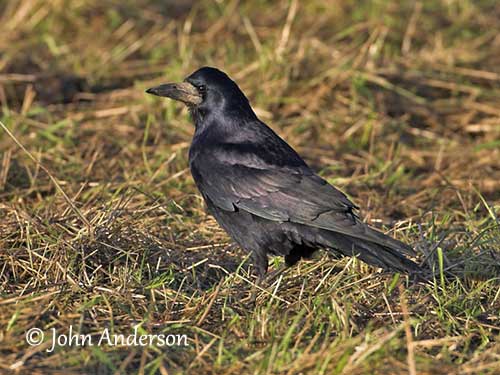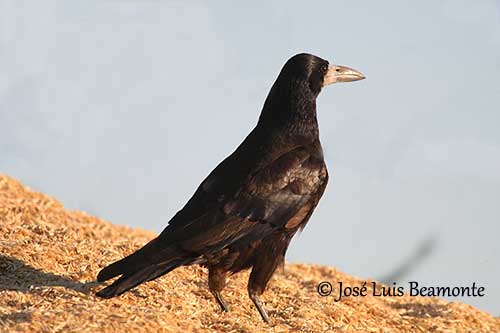
Fr: Corbeau freux
Ang: Rook – Eurasian Rook
All: Saatkrähe
Esp: Graja
Ita: Corvo comune
Nd: Roek
Sd: råka
Photographers:
John Anderson
John Anderson Photo Galleries
José Luis Beamonte
Pájaros de España
Steve Garvie
RAINBIRDER Photo galleries & Flickr Rainbirder
Ingo Waschkies
Bird Photography
Text by Nicole Bouglouan
Sources:
HANDBOOK OF THE BIRDS OF THE WORLD Vol 14 by Josep del Hoyo-Andrew Elliot-David Christie - Lynx Edicions – ISBN: 9788496553507
CROWS AND JAYS by Steve Madge – Ed. Christopher Helm – ISBN: 0713652071
THE COMPLETE BOOK OF BRITISH BIRDS – Written by “Royal Society for the Protection of Birds” experts - Préface de Magnus Magnusson - Michael Cady- Rob Hume Editors - ISBN: 0749509112
THE HANDBOOK OF BIRD IDENTIFICATION FOR EUROPE AND THE WESTERN PALEARCTIC by Mark Beaman, Steve Madge - C. Helm - ISBN: 0713639601
ENCYCLOPEDIE DES OISEAUX DE FRANCE ET D’EUROPE – de Peter Hayman et Rob Hume - Flammarion – ISBN : 2082009920
BIRDS OF THE MIDDLE EAST by R.F. Porter, S. Christensen, P Schiermacker-Ansen C.Helm - ISBN: 0713670169
Pájaros de España (JL Beamonte)
Animal Diversity Web (University of Michigan Museum of Zoology)
New Zealand birds and birding (Narena Olliver)
Rook
Corvus frugilegus
Passeriformes Order – Corvidae Family
INTRODUCTION:
The Rook differs from other Corvidae species by a morphological feature: it has bare, pale grey skin around the base of the bill, on lores and chin. This species is a colonial nester, and numerous nests can be seen at treetops. It is a very sociable bird that feeds and roosts in flocks during winter.
The Rook frequents mainly lowlands, and is usually less common in the uplands. Gregarious and quarrelsome, they are accused of damaging crops when some flocks feed in cultivated fields.
Two subspecies share the wide range extending from NW Europe, through central Europe to Asia (race pastinator). This species has been introduced in New Zealand where it is now considered an invasive pest.
The Rook is not globally threatened, although fluctuations of population are due to changes in the habitat for agricultural expansion, and persecution.

DESCRIPTION OF THE BIRD:
Biometrics:
Length: 44-46 cm
Wingspan: 81-94 cm
Weight: 325-570 g
The Rook has black plumage overall, with bluish and purplish gloss especially on wings. Head and neck plumage is dense and silky. It differs from Carrion Crow and Hooded Crow by a conspicuous bare whitish area of bare skin around the bill base, on lores and chin.
The pointed, slightly down-curved bill is greyish towards the tip, and whiter towards the base. The nostrils are well visible, due to lack of nasal bristles. The eyes are dark brown. Legs and feet are dark grey.
Male and female are similar.
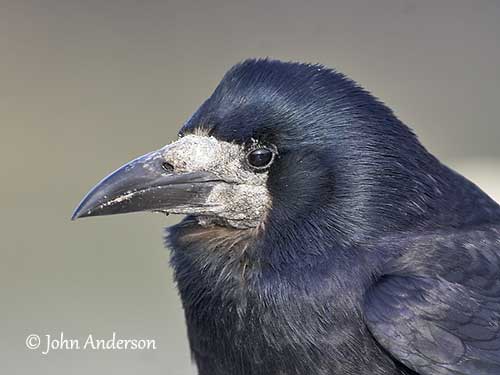
The juvenile is duller black than adults. Nape and mantle are browner. Unlike adults, it has fully feathered bill base and face, and shows a nasal tuft. It becomes similar to adults at 10-15 months, with bare face and absence of nasal tufts.
SUBSPECIES AND RANGE:
The Rook has two subspecies.
C.f. frugilegus breeds from S Sweden, S Norway and W Finland, British Islands, France and N Spain, E across Europe (N of Alps) and W Siberia to Asia Minor, Armenia, Azerbaijan and NW Iran, N through Caucasus regions to S Russia, and from S Kazakhstan E to foothills of Tien Shan and extreme NW China.
The northernmost populations migrate S to Mediterranean Basin and Middle East, through Iran and Afghanistan, NW China and NW Indian Subcontinent.
The nominate race has been introduced in New Zealand, in S part of North Island, and in Canterbury area on South Island.
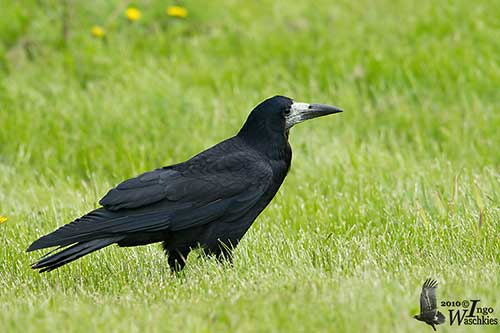
C.f. pastinator breeds from C Siberia and N Mongolia, E to SE Russia, and in C and NE China.
The northern populations migrate to E China, Korea and Japan.
This race has feathered face and chin, and only the bill base is whitish. Head and neck show mostly dull reddish-purple gloss. The northern populations have mostly bluer gloss and are slightly smaller.
HABITAT:
The Rook usually frequents farmland with small, scattered woodlands, flooded and/or temperate grasslands and cultivated areas for foraging. It often nests in tall trees close to towns and villages, and can be seen in large city parks.
This specie sis usually present below 400 metres in Europe, but it can be seen at higher elevations according to the range. It breeds at 2000 metres of elevation in C Asia.
CALLS AND SONGS: SOUNDS BY XENO-CANTO
The Rook gives harsher « kaah » than the Carrion Crow. When it is alarmed, it utters a high-pitched, almost plaintive “kraa-a”. We can also hear various other shorter calls and high-pitched yelps while the birds fly over the breeding colony.
The Rook « sings » from exposed perch and often gives soft cawing sounds, gurgling, rattling and crackling calls while moving the head forwards and backwards. About 20 calls have been documented during the breeding season.
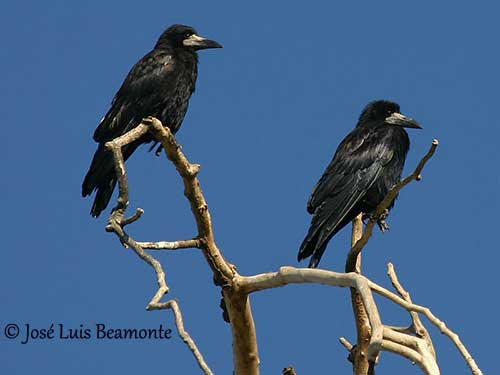
BEHAVIOUR IN THE WILD:
The Rook is omnivorous and feeds on animal and vegetal food items. It feeds mainly on earthworms and numerous small invertebrates such as beetles and Tipulidae larvae, but also small lizards, frogs, small mammals and eggs and nestlings of small bird species.
It also consumes grain, seeds and berries in autumn and winter. It may cause crop damage when flocks are feeding in cultivated fields. It takes less carrion than other crows.
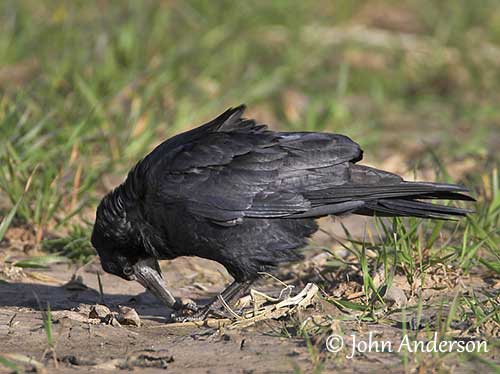
It forages by walking and hopping, stopping for probing or digging. It also scavenges at picnic sites and feeds along the shores of lakes and sea.
It sometimes forces other birds to drop food by chasing them in flight. In autumn, it often stores food such as pine cones, acorns or walnuts for the winter. It puts them in a hole covered with grasses.
Like most Corvidae, the Rook is monogamous with strong pair bonds sustained through the year and often for life. It is colonial nester and forms rookeries of some pairs to thousands (2,000 to 50,000). The colonies are established in stands of tall trees with up to 60 nests in the crown of very large trees. They breed in mixed-species colonies with cormorants and herons. Some old nests are sometimes used by falcons too.
The nest is tended by a single pair that defends a very small area around it. The birds feed in the areas around the colony, and usually, they are not aggressive towards each other.
In early spring, at the beginning of the breeding season, activity and noise reach a peak at the colony. The birds quarrel over territories with chases in flight around the rookery. They display by bowing, tail fanning and wing drooping.
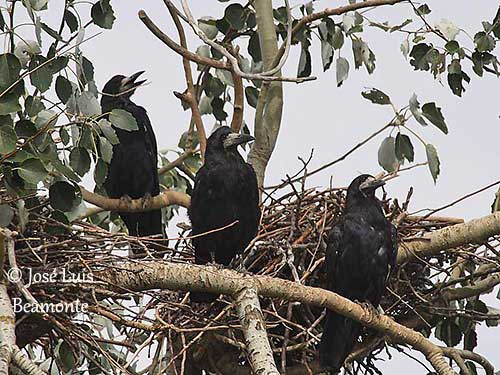
The Rook is resident in W and S parts of the range, and migratory in N and E. In New Zealand, they disperse widely after breeding, with vagrants reaching Stewart Island and Chatham Islands.
The genus Corvus has fairly long wings and short, rounded tail, allowing the crows to perform long, continuous, strong flights with deliberate wingbeats.
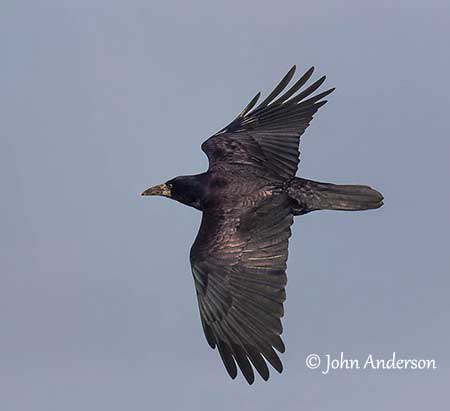
REPRODUCTION OF THIS SPECIES:
The breeding season takes place from mid-March to mid-April/early May from W to E of the range. They breed during the austral spring in New Zealand. The Rook produces a single brood per season.
The rookery includes numerous nests placed at treetops, in crown of large trees. The nest is built by both adults, with the male bringing material to the female. It is made with twigs and sticks, and the cup is lined with roots, dry grasses and leaves. The bulky structure is often repaired and reused in several following years.
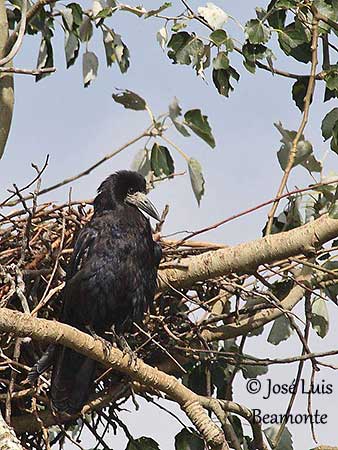
The female lays 4 (2-7) blue to grey-green eggs. She incubates alone during 16-18 days. The chicks are fed by both parents, often by the male alone during the first ten days. The young leave the nest 30-35 days after hatching, and can fly well at 42-45 days old. They still depend on parents for 6 weeks after fledging. They can breed at 2 years, sometimes earlier.
PROTECTION / THREATS / STATUS:
The Rook of nominate race is abundant, whereas the race pastinator appears to have declined over much of its wide range, probably due to pesticides.
The European breeding population is estimated to number 8,170,000/14,200,000 pairs (2015). A very preliminary estimate of the global population size is 54,300,000/94,700,000 mature individuals.
The Rook is currently evaluated as Least Concern.
